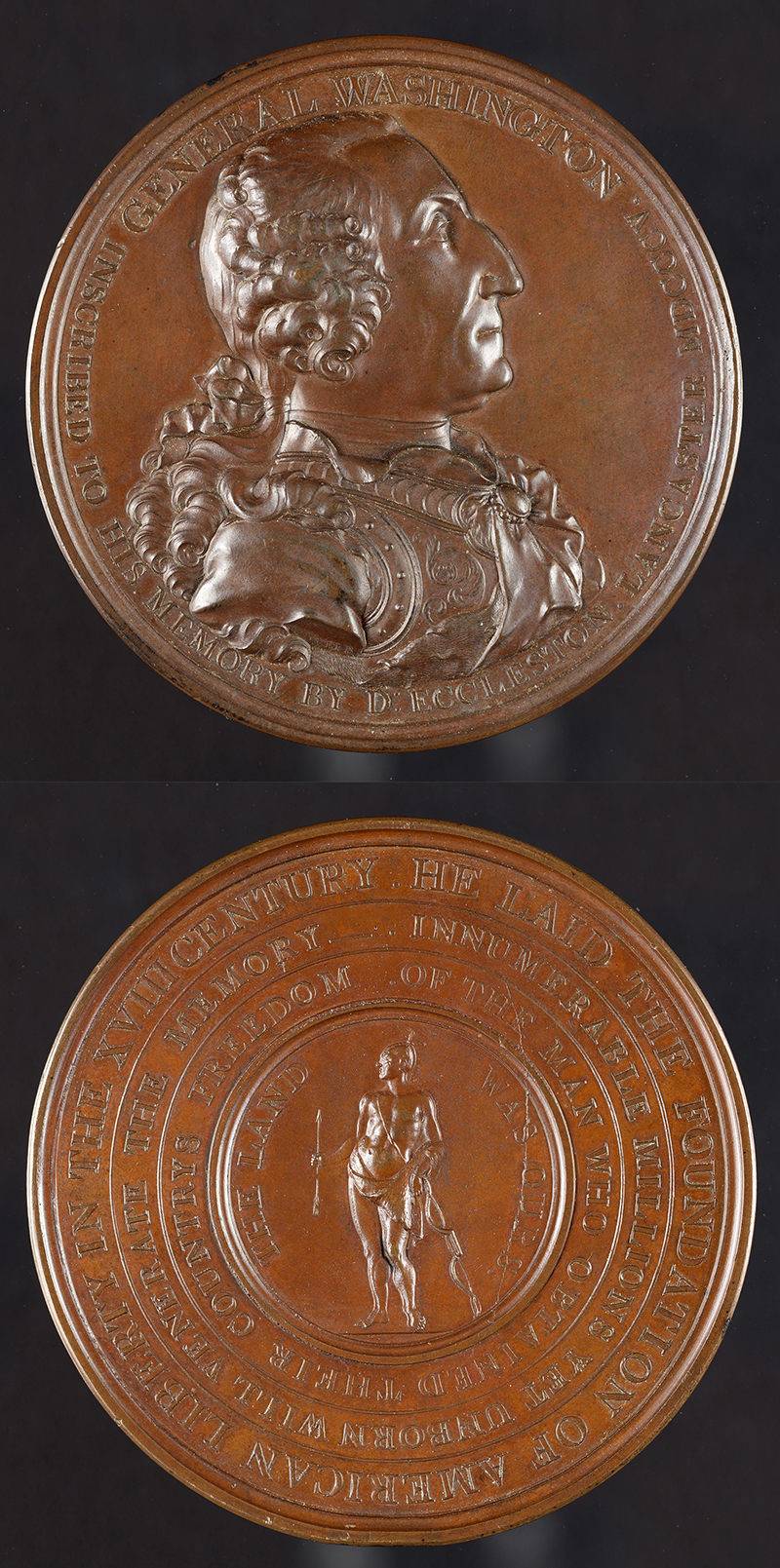The Museum acquires a rare copy of the 1805 Eccleston medal of George Washington
By Bowdoin College Museum of Art
General Washington Inscribed to His Memory by D. Eccleston, MDCCCV, 1805, bronze by Thomas Webb, British, active 1804–1827. Acquired in honor of Jackie Brown, Associate Professor of Art, with funds provided by an anonymous donor. Bowdoin College Museum of Art.
With support from a generous anonymous donor, the Museum of Art was able to purchase recently at auction a copy of the Eccleston medal of George Washington, regarded as one of the most important medals honoring America’s first president. Created in 1805, six years after his death, this large bronze medal portrays Washington as a military leader dressed in metal armor, a costume from the imagination of British artist Thomas Webb (active 1804–27) and not something Washington would ever have worn. Webb had never seen Washington in-person and his portrayal is likely based on popular prints of the period.
The medal is named for Daniel Belteshazzar Plantagenet Eccleston (ca. 1745–1816), a British merchant and insurance broker who lived in Lancaster, England. As a young man, he traveled on several occasions to North America, visiting Canada, the United States, and different British colonies in the Caribbean. Eccleston supported the fledgling United States after the Revolutionary War and—like many Europeans and Americans alike—was a great admirer of Washington. On one trip, he visited him at Mount Vernon, Washington’s plantation in Virginia.
Eccleston commissioned Webb to produce bronze medals to honor Napoleon Bonaparte in 1802 and George Washington in 1805. He sent the Washington medal to various Americans, including then-President Thomas Jefferson, Washington’s nephew Bushrod Washington, and Supreme Court chief justice John Marshall. Jefferson designed a circular frame for his copy of the medal and hung it in his home Monticello in Virginia.
In his letter of gratitude to Eccleston, Jefferson wrote in 1807: “[T]hat our own nation should entertain sentiments of gratitude & reverence for the great character who is the subject of your medallion, is a matter of duty. His disinterested & valuable services to them have rendered it so, but such a monument to his memory by the member of another community, proves a zeal for virtue in the abstract, honorable to him who inscribes it, as to him whom it commemorates.”
It is believed that Eccleston—a Quaker—sympathized with the Native peoples in North America and was critical of their mistreatment and the dispossession of their lands. Evidence to support this claim includes the addition of a Native figure on the medal’s verso with the inscription, “The Land Was Ours.” This unidentified man is pictured semi-nude, holding a bow and arrow. His representation as a “noble savage” aligns with racist perceptions shared by many non-Natives in North America and Europe during this period.
The Museum of Art is fortunate to own one of the largest and most distinguished collections of medals in the United States. Created mostly in Europe and the United States, these medals span nearly 600 years, from the early 15th century to the present day. In the last several years, with the involvement of Museum staff and several Bowdoin faculty and students, this collection has been digitized, made available on-line, and selected highlights installed in a special student-curated exhibition. The Eccleston medal has been given in honor of Jackie Brown, an associate professor of visual arts and an accomplished sculptor who has used examples from the Museum’s medals collection in various courses she has taught.
The Museum is pleased to add this medal to its collection. It exemplifies the high regard that many held Washington, especially in the years immediately after his death. Created in the same year as the Museum’s celebrated portraits of Thomas Jefferson and James Madison by Gilbert Stuart, it invites productive conversations about this period in European and American history, about the role of artists in memorializing distinguished statesmen, and about the dominant society’s understanding of Native peoples.
Frank GoodyearCo-Director, Bowdoin College Museum of Art